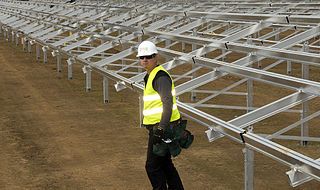2GreenEnergy Intern To Explore the Cutting-Edge of Technology Behind Solar Photovoltaics

Rather that send him his list privately, I thought I’d create a blog post and just send him the link. Here’s the list:
• Thin-film just set a record in efficiency; I believe someone just broke the old record of 16.1% and hit 17%. What were the circumstances? What are the upper limits of thin-film efficiency and what exactly imposes them?
• What are the projected costs of product based on this technology, and what does this imply for the future in terms of cost-effectiveness of PV generally?
• What wild new technologies lie on the horizon? What about quantum wells and other attempts to dislodge more than one electron with a single photon? How does the Mossbauer Effect (where a photon is absorbed into a matrix, rather than by a single electron) come into play here?
• What’s happened with other chemistries, e.g., Cd-Te?
• Speaking of tellurium, let’s explore materials’ issues. There are no tellurium mines; it comes from the mining of copper. Cadmium, like arsenic, is toxic. We’re all enamored of cadmium telluride as a non-silicon PV substrate, since it’s apparently very easy to work with — a “manufacturer’s dream” I’m told. But what happens if we wind up with a surplus of cadmium?
• What about potential shortages? I.e., the “I” in the solar PV technology “CIGS” is indium. But just like tellurium, there are no indium mines; the world’s indium comes as a by-product from mining zinc, and we mine zinc largely for its role in producing steel for the building industry. So what happens when the building industry experiences its peaks and valleys?
• How does the utility model in the U.S. affect the solar market? Everyone seems to be concerned about the utilities’ “death spiral,” driven by people buying less energy from the grid, thus driving up the price of electricity for everyone else—thus encouraging even more distributed generation?
• How are hedge funds that focus on solar doing, e.g., Boston-based Esplanade Capital? When I interviewed Esplanade’s CEO Shawn Kravetz about a year ago, we laid out a long list of reasons to be bullish. Are those reasons still valid?
• What are the opportunities for CPV (concentrated PV)?
• Do advancements in PV mean that CSP has no future? Certainly a number of high-profile CSP projects that were slated to be built in California in the past few years were converted to PV because of the precipitous fall in PV prices. I’ve always hoped that CSP will enjoy the opportunities for the same level of R&D that was experienced by PV (and wind). Is this doomed to failure, caused by the success of PV?
We’re thrilled to have you on board, Avdit. Please call and let’s discuss the list here, and perhaps add more items to it. I look forward to working with you.
